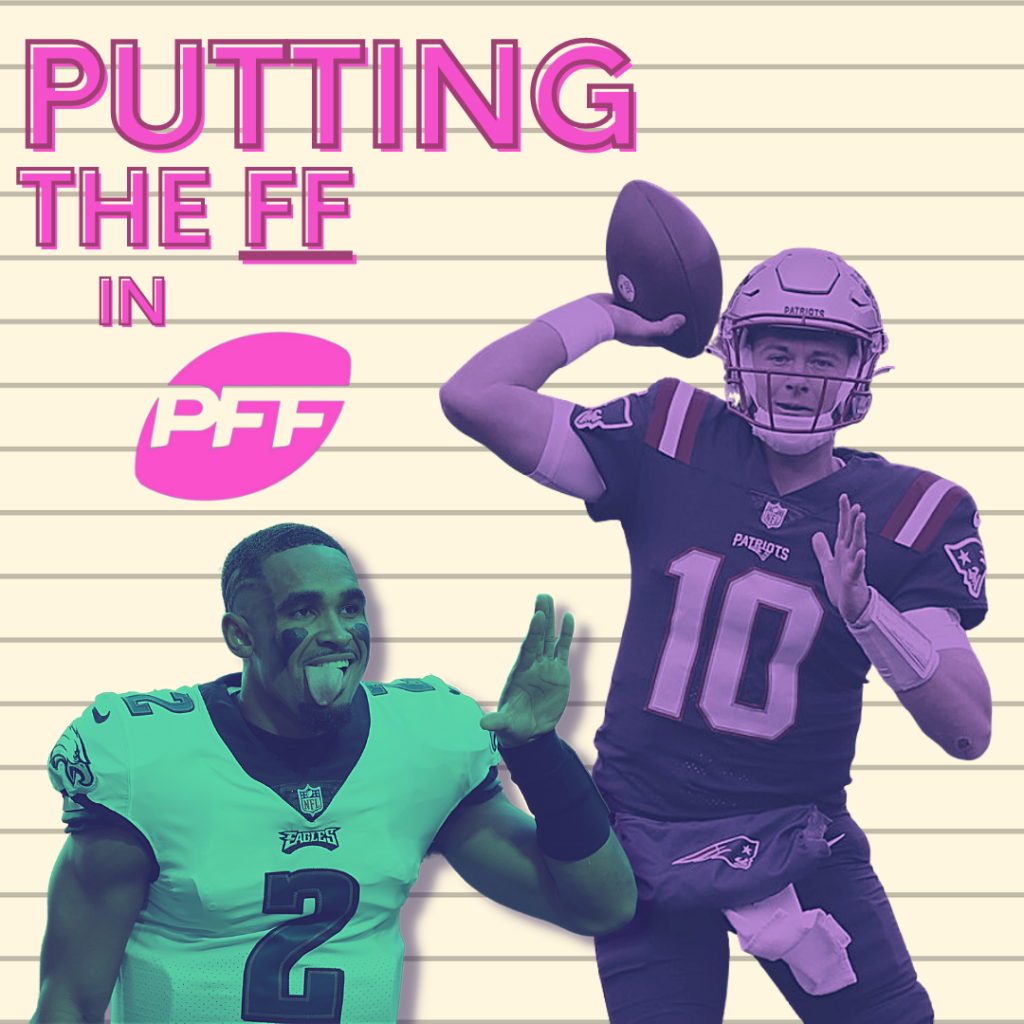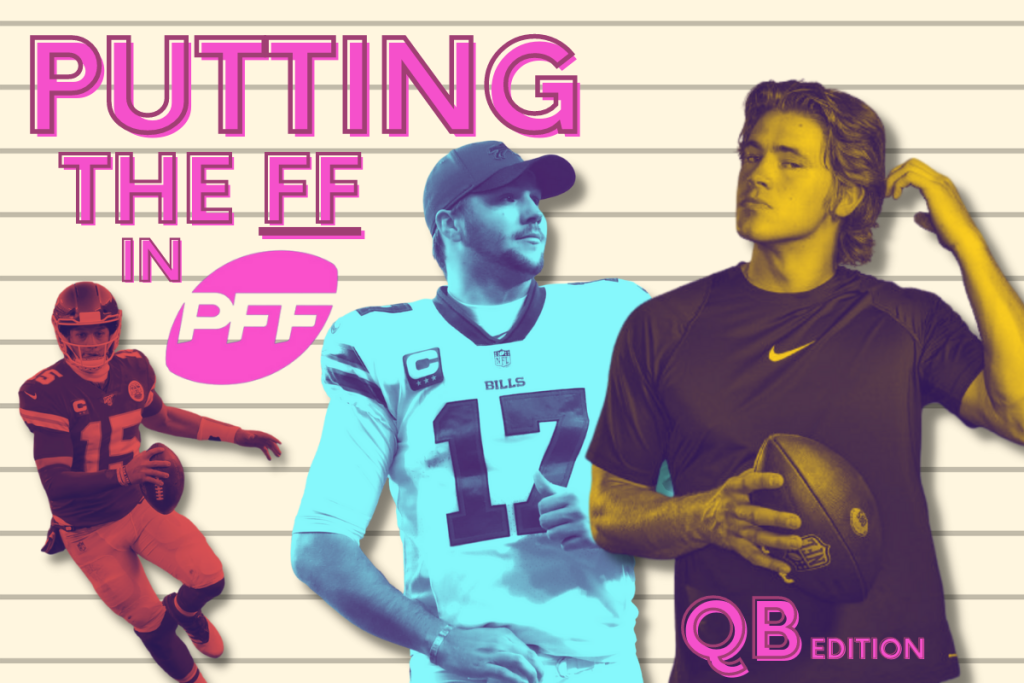If you have been paying attention to football at all in the last few years, you have most likely heard PFF grades used during conversations about NFL players.
What is PFF?
What exactly IS a PFF grade though?!
The acronym PFF stands for Pro Football Focus. PFF is a sports analytics company owned by former NFL player and current NFL commentator Cris Collinsworth. They focus on providing a detailed analysis of all NFL (and now NCAA Division I) players. They assess each player on every play they take part in during any game of the season. Then, they chart these performances on a grading scale. After assessing every individual play, PFF assigns player grades on a scale of 0-100. (They do provide other services as well. They specialize in advanced statistics for players and teams, but that is a tale for another time.)
Simply put, they are giving a number score (or “grade”) to a player’s performance. You can then easily see how they compare to other players at their position. A way to help distinguish good “real-life” NFL play from mediocre or bad.
Does PFF help my fantasy team?!
I’m glad you asked!
There is no doubt that PFF has become more integrated into the vernacular of the NFL. You may have even started hearing some of your favorite fantasy analysts utilizing PFF grades in their discussions on players or teams.
The major question in my mind has been, how relevant is that to fantasy?
We know that PFF is primarily focused on distinguishing good “real-life” NFL play from bad. We also know that PFF is not focused on fantasy football performance. I think we can all agree that good real-life NFL players don’t always make good fantasy football assets for our squads.
Is there a crossover?

Does a top PFF grade equate to a top fantasy asset?! Do top fantasy finishers tend to have top PFF grades?!
Is the answer the same or similar across different positions? Is it something that can be cross-referenced? Could this simply be an “apples to oranges” situation that sounds good in theory but is not applicable in practice?
With all these questions swirling around in my brain, there was only one thing for it.
A deep dive!
I love a good deep dive and this seemed as worthy a cause as any. I decided to lock myself in the office (for far too long) and try to give some actual answers to these hypothetical arguments I had created for myself.
Deep Dive
Firstly, I needed to clarify a set of parameters in my attempt to contextualize the answers I was going to offer up. I decided to look at top-12 finishes by position over the last five years.
Why five years?
Partly, I felt like the actual NFL, as well as fantasy football, has been evolving quite rapidly recently. I figured that going back much further than that may not be as useful as you would think. (I also partly didn’t want this to be an article series coming out in 2025, so there is that as well.)
Basically, I am looking at top-12 PFF grades from 2017 to 2021 vs. top-12 fantasy football finishes over the same period. I looked at PFF grades just from the regular season (as that is what applies to us in fantasy) and FF finishes between weeks 1-16 up until 2021 and then 1-17 in 2021.
I assigned the delineation of ten games as the “magic number” that a QB needed to compete in each season to be considered for this exercise. (I think it would be slightly unfair to include QBs in a data set that only played four or five games. Using them to either exclude or include a group of players might then skew the results.) I felt that ten+ games would be a significant enough portion of the season to warrant inclusion in year-end grades or finishes.
Important side note
At this point, I can hear at least one angry reader slamming their fist on the table and shouting at the top of their lungs:
“FANTASY FINISHES ARE NOT AS IMPORTANT AS POINTS PER GAME!!!!!!!”
To that reader, I would say, “…chillax”, for starters.
Then I would say, “I get what you are saying and I (mostly) agree with you.” (Maybe not to the yelling at the top of my lungs extent), but enough so that I have included those numbers in the research as well!
Friends again?! Good!
Since we are on the subject, I think the actual findings might surprise you. The average difference over the last five years between a top-12 end-of-season vs. a top-12 PPG finish was only 0.2 PPG on average!
On top of that, of the sixty potential top-12 finishers over the past five years, only four quarterbacks were in the top-12 PPG in a year and not inside the top-12 end-of-year finishes. Of those four, two of them were due to injury or taking over as starter part-way through a season. (Drew Brees and Ryan Tannehill both completed 10 and 11 games respectively in 2019 and finished inside the top-12 in PPG but missed out on the top-12 in total points scored.)
It is only 7% of the entire group that would hit the PPG threshold yet be excluded from the end-of-year top-12 finish for that season. If you want to take those two out because of extenuating circumstances (which I prefer) it becomes 3.5%. Either way, I won’t lose much sleep over the distinguishing between fantasy finishes and PPG when talking QBs (at least in this exercise.)
Now that we cleared that up, on with the show!
FF vs PFF
Here it is folks, the juicy and un-adulterated truth of FF vs PFF top-12 finishes for the quarterback position!!!
(Drumroll, please.)
While there is some fluctuation year-to-year, the bottom line numbers suggest that there is a fairly strong correlation between top-12 PFF grades and top-12 fantasy finishes!
Between 2017-2021 there was a 70% crossover between QBs that finished top-12 in both PFF grades and fantasy football finishes. The lowest number was in 2017 & 2019 when only 58% of the QBs had a crossover. In 2018 & 2020 the number was a healthy 75%. In 2021, only two QBs did NOT crossover which was a fantastic 83% crossover rate!
In fact, if you had drafted your QBs based solely on PFF grades, there was only an average difference of 0.78 PPG vs. fantasy football top-12 finishes. The 0.78 is in favor of the fantasy finishes (which is expected) but is a five-year average of less than a single point per game!
Further notes
I did attempt to look into the repeatability or consistency of top-12 finishes within these parameters. However, as you can imagine with injuries and retirements it is quite difficult to provide solid conclusions. I will however offer some observations from this study of a five-year sample size.
There was only one QB that managed to run the gauntlet and finish inside the top-12 of PFF grades every single year. It was unsurprisingly the goat himself, TB12. However, not even Brady managed to finish top-12 in fantasy all five years.
A trend worth noting is that when a young QB first finishes on a top-12 list (if they don’t hit both), they seem to hit both thresholds the following year. (If they are taking the next steps we expect from a young QB we hope is ascending.)
Deshaun Watson took that leap in 2018 and repeated it in 2019 and 2020. Josh Allen and Kyler Murray jumped into the top-12 of fantasy finishes in 2019 but missed the top-12 PFF grades. They both secured their places on the crossover list in 2020 and repeated in 2021.
A young gun that seems to be following suit is Justin Herbert. He finished inside the top-12 in fantasy as a rookie in 2020 but missed the cutoff for PFF. He then locked in a top-12 finish in both fields in 2021. Personally, I would expect that to continue.
Players to watch
A player that hits this threshold and could be a surprise to some, is Jalen Hurts. He only started three or four times as a rookie in 2020. In 2021, he finished 8th in fantasy and 10th on PFF’s top-12 regular-season list with a grade of 80.8! This could be a promising sign for the Hurts faithful out there!

Another player to keep an eye on is Mac Jones! He quietly locked in a top-12 PFF grade for the 2021 regular season!
He actually had a higher regular-season PFF grade than Patrick Mahomes! He could be someone to watch out for making a sneaky run at the top-12 fantasy finishes table for 2022.
Conclusion
I would say that PFF grades seem to have a fairly strong correlation to solid fantasy production. At least at the QB position. The QBs that are regular repeaters on the top-12 of PFF grades are guys you would want to rely on for your fantasy squads. The PFF grades suggest players that are actually succeeding in the NFL and not just for fantasy. In theory, they should be safer bets for your dynasty rosters. You would assume that a good real-life NFL QB is the one most likely to stick around and get further opportunities. In turn, that adds stability and longevity to a pivotal position on your fantasy team.
Please don’t hear what I’m NOT saying. It is NOT a fool-proof one size fits all approach, but then again nothing is in fantasy football. I think it is a relevant and useful piece of the puzzle.
Hopefully, you found this interesting and not too confusing! I look forward to sharing the results of the other positions and seeing if they are equally positive or more volatile.
Until next time!
Evan


















